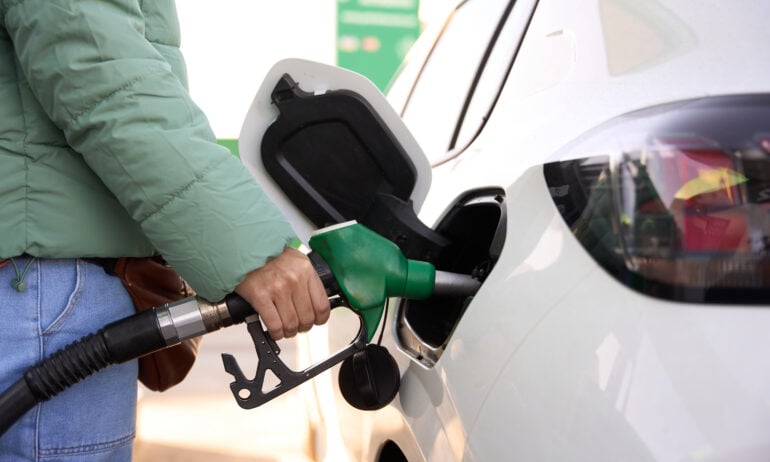State Gas Taxes: What They Are And How Much You Pay
State taxes vary widely but average 33 cents per gallon.

Many, or all, of the products featured on this page are from our advertising partners who compensate us when you take certain actions on our website or click to take an action on their website. However, this does not influence our evaluations. Our opinions are our own. Here is a list of our partners and here's how we make money.
Gas tax rates increased in seven states in the new year. With that, drivers in Florida, Georgia, Massachusetts, Minnesota, Nebraska, New Jersey and Utah can expect to pay slightly more for each gallon of gas.
The increases in each state are small, ranging from less than 1 cent to 3.3 cents per gallon. But state taxes can add a chunk of change to the overall price of fuel. When the changes took effect on Jan. 1, the total state gas tax rates for those spots became:
New Jersey: 45 cents per gallon.
Florida: 39.4 cents per gallon.
Utah: 39.2 cents per gallon.
Georgia: 33.9 cents per gallon.
Minnesota: 33.9 cents per gallon.
Nebraska: 31.3 cents per gallon.
Massachusetts: 27.4 cents per gallon.
Meanwhile, a few states reduced their fuel taxes effective Jan. 1. New York and North Carolina make annual adjustments to their tax rates, and the calculations for 2025 resulted in a smaller tax. The same is true in Vermont, where one fee is adjusted quarterly, and in Michigan, where the prepaid sales tax rate is revised monthly.
Understanding gas taxes
The price of oil and the cost of refining it are the biggest determining factors in the price of gas, which averaged $3.02 per gallon in December. But federal, state and local taxes and fees can add significantly to the total.
On top of a federal tax of 18.4 cents per gallon, most states levy multiple taxes and fees on a gallon of gas. Those include some combination of excise taxes (imposed on goods, services and activities), sales taxes, environmental taxes and inspection fees.
Those costs add up to an average of 32.9 cents per gallon in state taxes, according to a NerdWallet analysis of U.S. Energy Information Administration data. Combined with the federal tax, that’s about 51.3 cents per gallon, on average, factored into the gas prices you see at your local station.
States with the highest gas tax
State tax rates vary widely. California’s rate (69.8 cents per gallon) and Illinois’s rate (67.1 cents) are highest, followed by Pennsylvania (58.7 cents). Alaska has, by far, the lowest state tax (9 cents per gallon), followed by Mississippi (18.4 cents) and Hawaii (18.5 cents).
State gas tax rate changes in 2025
In many cases, gas taxes are adjusted annually based on the consumer price index, a proxy for inflation calculated by the U.S. Bureau of Labor Statistics. That means taxes may rise (or fall) with the annual rate of inflation. Sometimes states also phase in new or higher fees by increasing them incrementally.
As for what happens with that tax revenue, states often use it to fund infrastructure improvements and environmental initiatives.
Here’s a more detailed look at where tax rates changed on Jan. 1.
States with rising tax rates
In Florida, the state sales tax on gas increased by half a cent to 17.5 cents per gallon, while the State Comprehensive Enhanced Transportation System Tax ticked up by less than a cent to 9.7 cents per gallon, according to the Florida Department of Revenue. Florida drivers also pay a 4-cent excise tax, as well as other environmental fees on gas. Altogether, state taxes and fees come to 39.4 cents per gallon.
In Georgia, the state excise tax on gas increased by eight-tenths of a cent to 33.1 cents per gallon according to the Georgia Department of Revenue. When combined with a small environmental fee, Georgia drivers will pay about 33.9 cents per gallon of gas when they fill up.
In Massachusetts, a fee that funds the state’s underground storage tank cleanup fund increased to about 3.4 cents per gallon, according to the Massachusetts Department of Revenue. That is combined with a small environmental fee, as well as a 24-cent excise tax. In all, drivers pay about 27.4 cents per gallon.
In Minnesota, the state excise tax on gas rose by 3.3 cents to 31.8 cents per gallon, according to the Minnesota Department of Revenue. Drivers also pay about 2.1 cents per gallon in environmental fees, bringing the state taxes total to 33.9 cents per gallon.
In Nebraska, the state motor fuels tax rate rose by eight-tenths of a cent to 30.4 cents per gallon, according to the Nebraska Department of Revenue. The tax doesn’t include a small environmental fee. In all, Nebraska drivers pay 31.3 cents per gallon in state taxes.
In New Jersey, the “petroleum products gross receipts tax” increased 2.6 cents to 34.4 cents per gallon, according to the New Jersey Department of the Treasury. When added to a 10.5-cent excise tax and a small environmental fee, drivers in New Jersey pay about 45 cents per gallon in taxes and fees.
In Utah, the motor fuel tax rate went up by 2 cents to 38.5 cents per gallon, according to the Utah State Tax Commission. Drivers also pay an environmental fee that’s about seven-tenths of a cent per gallon. That brings the state’s total gas tax rate to about 39.2 cents per gallon.
States with falling tax rates
In Michigan, the monthly prepaid sales tax rate declined for the fourth consecutive month, according to the Michigan Department of Treasury. For January, it is 15.8 cents per gallon. That’ll be reset once again on Feb. 1. Combined with the state’s 30-cent excise tax on gas, as well as a 1-cent environmental protection fee, drivers pay 46.8 cents per gallon in state taxes and fees.
In New York, an annual adjustment to the state’s petroleum business tax reduced the gas tax by eight-tenths of a cent, according to the New York Department of Taxation and Finance. When added to an 8-cent excise tax, an 8-cent sales tax and other environmental fees, New York drivers pay state taxes of about 32.9 cents per gallon of gas.
In North Carolina, the motor fuels tax rate, which is adjusted annually, ticked down by one-tenth of a cent to 40.3 cents per gallon, according to the North Carolina Department of Revenue. Combined with an environmental fee, drivers pay 40.6 cents per gallon in state taxes on gas.
In Vermont, the “motor fuel transportation infrastructure assessment” is calculated quarterly. For the first three months of the new year, it is down seven-tenths of a cent to about 5.2 cents per gallon, according to the Vermont Department of Motor Vehicles. Drivers also pay an excise tax of 12.2 cents per gallon and other fees totaling 14.4 cents per gallon. In all, the Vermont state gas tax rate is about 31.8 cents per gallon.

